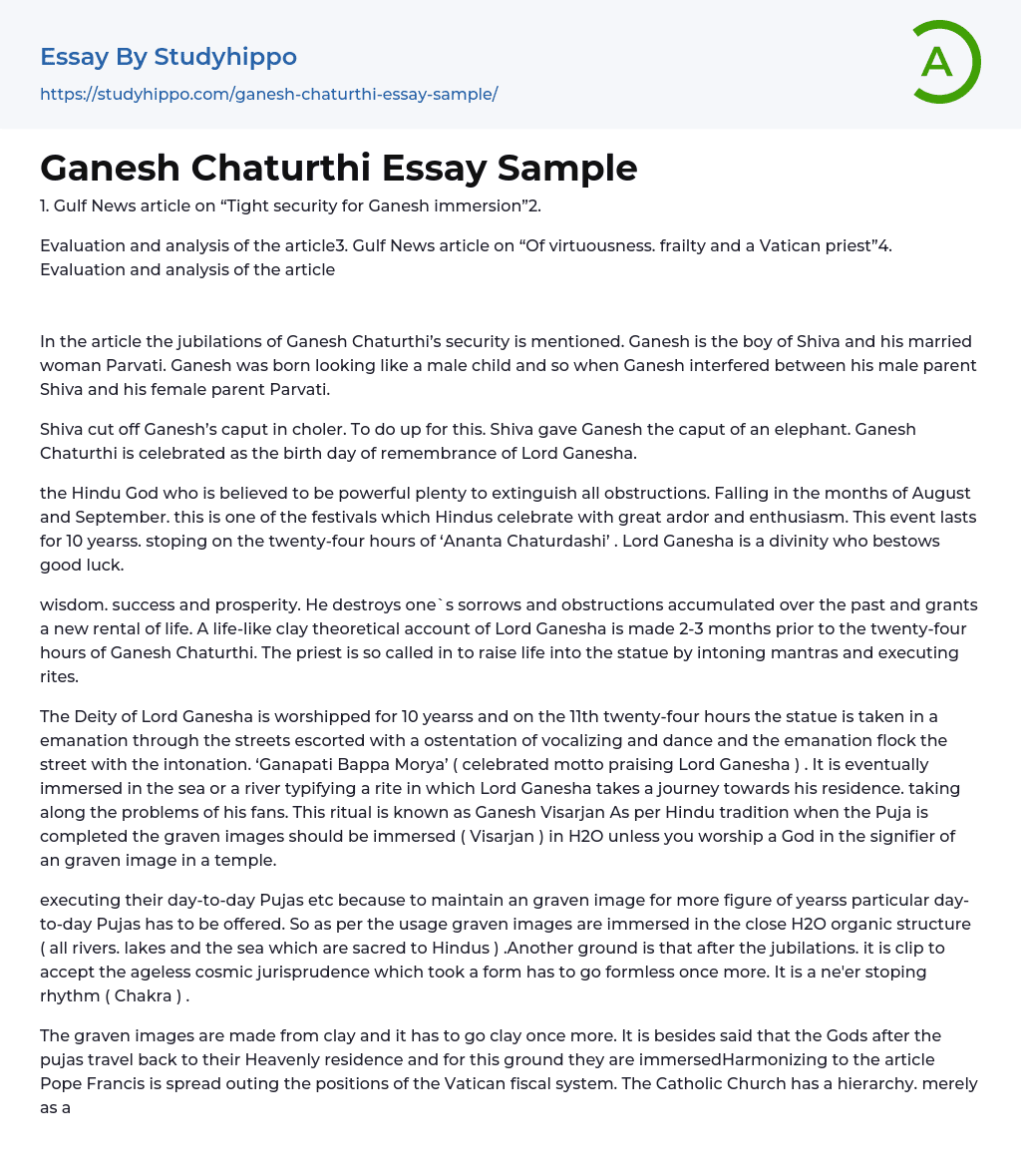Gulf News has published an article titled "Tight security for Ganesh immersion."
This text entails an evaluation and analysis of the Gulf News article titled “Of virtuousness, frailty and a Vatican priest”. The article discusses the security arrangements made for the celebration of Ganesh Chaturthi, who is considered the son of Shiva and his wife Parvati. Ganesh was born as a boy and his interference between Shiva and Parvati is also mentioned.
The celebration of Ganesh Chaturthi commemorates the birth of Lord Ganesha who, according to legend, had his head cut off by Shiva in a fit of rage. However, Shiva later atoned for his actions by replacing Ganesh's head with that of an elephant.
In August and September, Hindus celebrate the festival of Lord Ganesha with enthusiasm. This festival is highly regarded for its ability to conquer diffi
...culties and bring good luck. The festivities span ten days and end on 'Ananta Chaturdashi'.
Lord Ganesha is known for bringing wisdom, success, and prosperity to those who seek it. Additionally, he can remove past sorrows and obstacles to provide a fresh start in life. In preparation for Ganesh Chaturthi, individuals create a clay model of Lord Ganesha which is left to dry for several months. The priest then performs rituals and mantras in order to imbue the statue with life.
During a 10-day period, Lord Ganesha's Deity is worshipped and on the 11th day, it is carried in a procession through streets accompanied by singing and dancing. The chant "Ganapati Bappa Morya" fills the streets, praising Lord Ganesha. Eventually, the statue is immersed in water symbolizing Ganesh Visarjan where Lord Ganesha takes his devotees' problems with him on his journe
home. Hindu tradition mandates that after Puja is completed, idols are to be immersed (Visarjan) in water unless they are worshipped as an idol within a temple.
To maintain a sacred image for several years, daily Pujas must be performed. This is why images are immersed in the nearby bodies of sacred water (such as rivers, lakes, and the sea) according to tradition. Another reason for this practice is to accept the eternal cosmic law that dictates a form must become formless again after festivities. This is part of an endless cycle, known as the Chakra.
The idols made of clay return to clay once again and it is believed that after the pujas, the deities go back to their divine abode and are immersed. The Vatican economy is being reformed by Pope Francis, who is broadening its outlook. Similar to any other organized setup, the Catholic Church has a hierarchical structure.
The Church operates under a hierarchical structure which outlines the guidance of its followers at different tiers, beginning with the parish, followed by the bishopric and culminating in the archdiocese.
Peter was chosen by Christ to be the leader of the apostles and the Church, guiding it with his authority. He received the "keys to the kingdom" and whenever he acted or spoke as Christ's representative on Earth, he did so flawlessly.
The leadership role of the Catholic Pope, starting with Peter as the first Pope, has been passed down to his successors who have acquired his competence. This has resulted in the current Pope's infallible guidance on Earth. The present leader of the worldwide Catholic Church is Bishop of Rome Francis.
The position of the Pope
encompasses both religious and political roles, as he serves as the leader of the Catholic Church and head of state for Vatican City, a sovereign city-state located in Rome, Italy. Currently held by Pope Francis, this post involves fulfilling duties as Bishop of Rome and ultimate authority over Vatican City.
As the Supreme Pastor, the Catholic Pope engages in diplomatic relations with over 100 states, meets with provincial leaders, conducts Holy Eucharists, appoints bishops, and travels. Furthermore, he directly serves the faithful by acknowledging pilgrims at General Audiences, which typically draw crowds ranging from several thousand to tens of thousands of people.
Thus, the Pope embodies the love and compassion of Christ towards every single individual. Therefore, his primary focus is to get to know people, comprehend their lifestyles, attentively listen to their concerns, and share in both their sorrows and happiness.
- Puritans essays
- Afterlife essays
- Buddhism essays
- Christianity essays
- Deism essays
- Faith essays
- God essays
- Hinduism essays
- Islam essays
- Jews essays
- Judaism essays
- Monotheism essays
- New Testament essays
- Ritual essays
- Sin essays
- Soul essays
- Theology essays
- Confession essays
- Devil essays
- Miracle essays
- Monk essays
- Revelation essays
- Atheism essays
- Immortality essays
- Jainism essays
- Sinners essays
- Bible essays
- Old Testament essays
- Salvation essays
- Temple essays
- Taoism essays
- Pilgrimage essays
- Freedom Of Religion essays
- Existence of God essays
- Christian Worldview essays
- Cosmological Argument essays
- Gautama Buddha essays
- Karma essays
- Buddha essays
- Baptism essays
- Holy Spirit essays
- Jesus Christ essays
- Adam And Eve essays
- Crucifixion Of Jesus essays
- Crusades essays
- Eucharist essays
- God The Father essays
- Pope essays
- Protestantism essays
- Christian essays




